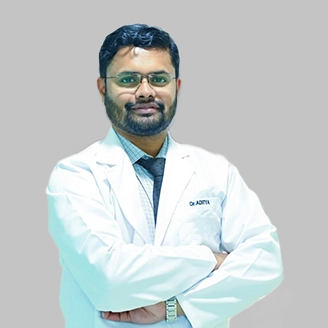Back pain has quietly become one of the most common causes of missed work and poor quality of life — especially among people who sit long hours or lead sedentary lives.
One major cause is Degenerative Disc Disease (DDD) — a gradual wear and tear of the spinal discs that act as cushions between vertebrae.

Spectrum of the Disease
Degenerative Disc Disease isn’t a single event — it’s a spectrum of changes:
- Early Stage: Mild back pain or stiffness after sitting or bending.
- Disc Bulge: The disc starts to protrude, pressing on nearby nerves.
- Disc Prolapse / Herniation: The disc ruptures, compressing the nerve root.
- Radiculopathy: Shooting pain, numbness, or tingling radiating down the arm or leg.
- Myelopathy: Severe nerve compression causing weakness, imbalance, or bladder issues.
These stages can range from mild discomfort to severe neurological symptoms.
A story from my practice
A 42-year-old office worker came to my practice with back pain radiating to the left leg for six months.
He spent nearly 10 hours a day sitting and had weak core muscles.
MRI showed L4–L5 disc bulge compressing the nerve root.
With physiotherapy, posture correction, and medications, his symptoms improved without surgery.
This case shows that early recognition and muscle strengthening can prevent major spinal problems.
Treatment Options
🩺 Medical Management
- Pain relief with anti-inflammatory medications
- Short course of muscle relaxants
- Postural correction and rest
- Weight management and ergonomic adjustments
💪 Physiotherapy
Physiotherapy is the backbone of long-term recovery.
It helps:
- Strengthen postural and core muscles
- Improve flexibility
- Enhance spinal stability
- Prevent recurrence of disc problems
Muscles and spine work together as one structure.
When postural muscles weaken (due to sitting too long or lack of activity), pressure on discs increases — leading to pain and degeneration.
🧠 Surgical Options
Surgery is indicated when:
- Persistent or worsening pain despite medical therapy
- Nerve compression causing weakness or numbness
- Loss of bladder or bowel control
- Recurrent disc prolapse
Common procedures include microdiscectomy, laminectomy, and spinal fusion — depending on the severity and location.
Importance of Posture and Movement
In today’s world of laptops and long work hours, poor posture is the silent enemy of the spine.
Tips for a healthy spine:
- Sit upright with feet flat and shoulders relaxed.
- Avoid slouching or leaning forward for long hours.
- Use a chair with lumbar support or small cushion behind the lower back.
- Take a 2-minute break every 30 minutes — stand, stretch, walk.
- When lifting objects:
- Bend your knees, not your back.
- Keep the object close to your body.
- Avoid twisting while lifting.
Final Thoughts
Degenerative Disc Disease is a manageable condition, not a sentence for lifelong pain.
With early diagnosis, regular physiotherapy, and proper posture, most patients recover fully without surgery.
But if symptoms persist or nerves are compressed, modern spine surgery offers excellent results.
Healthy spine, healthy life — movement is medicine.

About Dr. Aditya Sunder Goparaju
Services
- Open and minimally invasive spine surgery
- Interventional pain management procedures
- Navigation and robotic spine surgery
- Complex adult and pediatric spine deformity correction
- Traumatic spine conditions management
- Regenerative spine interventions
- Chronic cervical and low back pain management
